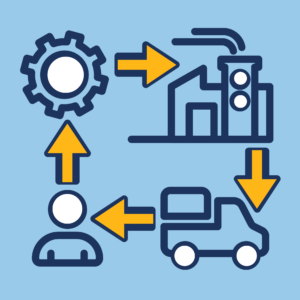By Melissa Burant, Supply Chain Project Manager, and Marc Schneider of CIRAS (Iowa MEP)
Polaris MEP is the Rhode Island Center for the MEP National NetworkTM, whose mission it is to strengthen and empower small and medium-sized manufacturing companies in the United States.
As a manufacturer you understand that supply chain disruptions happen all the time. What you don’t know is when or how they will impact your operation and business.
But assessing your supply chain risks and implementing good supply chain management practices can be daunting. This is especially true if you are among the many manufacturers that do not have dedicated supply chain personnel or formal training and tools for supply chain and inventory management.

Fortunately, there is a great way to gain visibility into your supply chain with a reasonable investment of resources: Map the supply chain for one of your key products.
People are driven by visuals; it’s easier to understand a map in comparison to reading a lot of numbers on a spreadsheet. Through a visual, it may become apparent where you need more robust safety stock and inventory buffers or how you can reduce variability.
A mapping exercise will help you identify risks and opportunities in a way that will resonate across your organization. Just as value stream mapping provides a window into the operation inside your facility, supply chain mapping will help you provide a roadmap for a wider overall supply chain risk management review.
You can start by collecting the data and creating an actual map that shows where you get your materials, where your suppliers get their materials, and where and how you ship your goods. Summarize your supplier information and build in some supplier performance indices.
In this blog we’ll look at a process for mapping your supply chain that was developed by Iowa State University’s Center for Industrial Research and Service (CIRAS), which is part of the MEP National Network. This process is available in Rhode Island through Polaris MEP.
Mapping Program Captures Key Data, Which Can Be Visualized
Kayla Viveiros leads Supply Chain Optimization Solutions at Polaris MEP, assisting Rhode Island manufacturers with no-cost supply chain “health assessments” and scouting/matchmaking.
A mapping program does more than identify weaknesses, risks, and opportunities. It also provides a deeper understanding of the costs and interdependencies related to suppliers. The foundational element is a repository for supply chain data that can be easily reviewed, shared, and updated. CIRAS has built templates for this process and has best practices for collecting data; other MEP Centers across the U.S. and in Puerto Rico such as Polaris MEP offer similar resources and services.
Having a detailed supply chain map allows you to visually represent many facets of your multi-tier supply chain. For example, you can show:
- Geographic concentrations of your suppliers and their suppliers.
- Where your most critical materials and parts come from, in terms of number of suppliers and geography.
- Where your most at-risk materials and parts come from.
- Sourcing for your highest volume materials or most common parts.
You might be surprised where your Tier 2 and 3 suppliers are located. You may be more dependent on overseas shipping than you think. Or you may want to pursue other options for your most critical materials or hard-to-find parts. This will help identify potential bottlenecks and opportunities for improvements.
Key Steps to Mapping a Supply Chain

The CIRAS program uses free tools and popular business software, such as Google Maps, Excel, and other Microsoft® Office products for flow diagrams, data summaries, and risk management tools. The keys steps are:
- Gather data: Select key supply chains to map, collect supplier data, part numbers, and spend. Being able to categorize parts will improve how much you can leverage the data.
- Identify key supplier relationships: This is referring to your suppliers’ suppliers. They are your Tier 2 and 3 suppliers.
- Map: Identify routings and transportation modes, which can reveal excess movements and risks from weather or port congestion.
- Create supplier risk index: The risk factors are coupled with your specific concerns (supplier’s on-time performance, responsiveness, etc.) to create a weighted risk score or index for each supplier. This feeds into the traditional risk review of the overall supply chain.
- Analyze and act: Brainstorm potential risks, develop recommendations to mitigate risks, start a regular risk review process.
Details Will Reveal Opportunities in Addition to Risks
You will get the most out of a supply chain mapping initiative by working with a partner who understands the many dynamics involved and can guide you through the details. The CIRAS program includes a weekly one-hour session to discuss a new topic and clarify how to complete the task.
One week the topic may be categorizing and segmenting purchased parts. Some parts are subject to many outside forces (such as semiconductors), some unique parts might be hard to source, and others may be more critical to your product. You can map any or all of these factors.
Your mapping partner will be able to help you identify your Tier 2 and 3 suppliers. You can ask your suppliers for help with this, but you may only get a name, so you may need to use a neutral third party to learn more. You may also learn which of your partners want to be more relational versus transactional. Are they eager to work with you? Do they even respond to your request?
While risk mitigation is important in your supply chain management, there is great value in knowing how you can leverage the supply chain to play to your strengths. You can play offense and defense at the same time.
Polaris MEP Can Help Rhode Island Manfuacturers With a Supply Chain Mapping Initiative
Many manufacturers are interested in improving their supply chain management but don’t know where to start. A mapping process can lead to more robust supplier performance reviews and overall supply chain risk management initiatives. For example, you might want to look at which strategic supply partners to visit and engage with.
Polaris MEP can help you with a defined process to map your key supply chains. Click here to learn more about our Supply Chain Solutions and to schedule a meeting with Kayla Viveiros, program manager.
Original Post: https://www.nist.gov/blogs/manufacturing-innovation-blog/mapping-your-supply-chains-helps-prioritize-risks-actions
